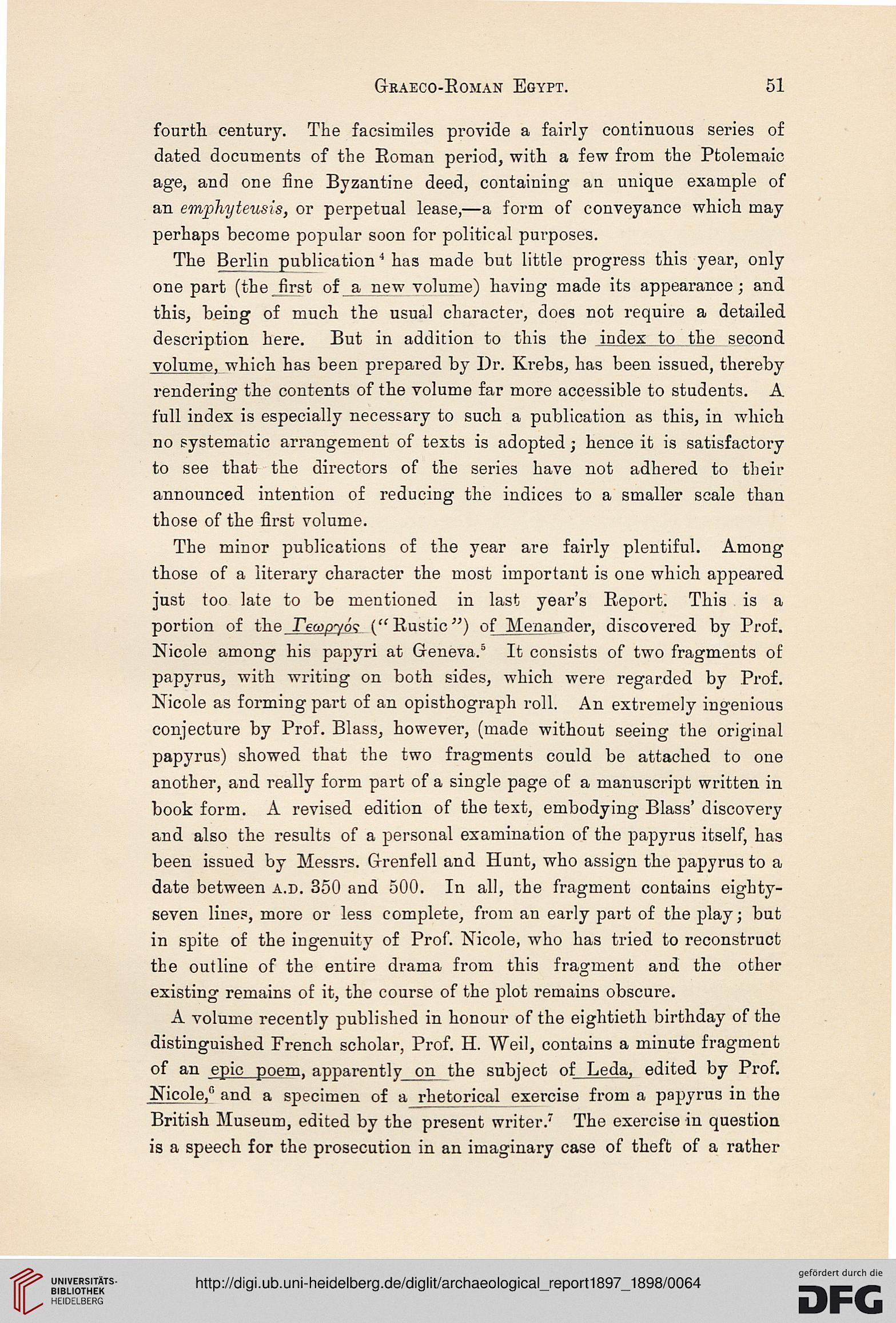Graeco-Boman Egypt.
51
fourth, century. The facsimiles provide a fairly continuous series of
dated documents of the Eoman period, with a few from the Ptolemaic
age, and one fine Byzantine deed, containing an unique example of
an emphyteusis, or perpetual lease,—a form of conveyance which may
perhaps become popular soon for political purposes.
The Berlin publication4 has made but little progress this year, only
one part (the jirst of a new volume) having made its appearance; and
this, being of much the usual character, does not require a detailed
description here. But in addition to this the index to the second
volume, which has been prepared by Dr. Krebs, has been issued, thereby
rendering the contents of the volume far more accessible to students. A
full index is especially necessary to such a publication as this, in which
no systematic arrangement of texts is adopted; hence it is satisfactory
to see that the directors of the series have not adhered to their
announced intention of reducing the indices to a smaller scale than
those of the first volume.
The minor publications of the year are fairly plentiful. Among
those of a literary character the most important is one which appeared
just too late to be mentioned in last year's Beport. This is a
portion of the Teoopyos ("Bustic") of Menander, discovered by Prof.
Nicole among his papyri at Geneva.5 It consists of two fragments of
papyrus, with writing on both sides, which were regarded by Prof.
Nicole as forming part of an opisthograph roll. An extremely ingenious
conjecture by Prof. Blass, however, (made without seeing the original
papyrus) showed that the two fragments could be attached to one
another, and really form part of a single page of a manuscript written in
book form. A revised edition of the text, embodying Blass' discovery
and also the results of a personal examination of the papyrus itself, has
been issued by Messrs. Grenfell and Hunt, who assign the papyrus to a
date between a.d. 350 and 500. In all, the fragment contains eighty-
seven lines, more or less complete, from an early part of the play; but
in spite of the ingenuity of Prof. Nicole, who has tried to reconstruct
the outline of the entire drama from this fragment and the other
existing remains of it, the course of the plot remains obscure.
A volume recently published in honour of the eightieth birthday of the
distinguished French scholar, Prof. H. Weil, contains a minute fragment
of an epic poem, apparently on the subject of Leda, edited by Prof.
Nicole," and a specimen of a rhetorical exercise from a papyrus in the
British Museum, edited by the present writer.7 The exercise in question
is a speech for the prosecution in an imaginary case of theft of a rather
51
fourth, century. The facsimiles provide a fairly continuous series of
dated documents of the Eoman period, with a few from the Ptolemaic
age, and one fine Byzantine deed, containing an unique example of
an emphyteusis, or perpetual lease,—a form of conveyance which may
perhaps become popular soon for political purposes.
The Berlin publication4 has made but little progress this year, only
one part (the jirst of a new volume) having made its appearance; and
this, being of much the usual character, does not require a detailed
description here. But in addition to this the index to the second
volume, which has been prepared by Dr. Krebs, has been issued, thereby
rendering the contents of the volume far more accessible to students. A
full index is especially necessary to such a publication as this, in which
no systematic arrangement of texts is adopted; hence it is satisfactory
to see that the directors of the series have not adhered to their
announced intention of reducing the indices to a smaller scale than
those of the first volume.
The minor publications of the year are fairly plentiful. Among
those of a literary character the most important is one which appeared
just too late to be mentioned in last year's Beport. This is a
portion of the Teoopyos ("Bustic") of Menander, discovered by Prof.
Nicole among his papyri at Geneva.5 It consists of two fragments of
papyrus, with writing on both sides, which were regarded by Prof.
Nicole as forming part of an opisthograph roll. An extremely ingenious
conjecture by Prof. Blass, however, (made without seeing the original
papyrus) showed that the two fragments could be attached to one
another, and really form part of a single page of a manuscript written in
book form. A revised edition of the text, embodying Blass' discovery
and also the results of a personal examination of the papyrus itself, has
been issued by Messrs. Grenfell and Hunt, who assign the papyrus to a
date between a.d. 350 and 500. In all, the fragment contains eighty-
seven lines, more or less complete, from an early part of the play; but
in spite of the ingenuity of Prof. Nicole, who has tried to reconstruct
the outline of the entire drama from this fragment and the other
existing remains of it, the course of the plot remains obscure.
A volume recently published in honour of the eightieth birthday of the
distinguished French scholar, Prof. H. Weil, contains a minute fragment
of an epic poem, apparently on the subject of Leda, edited by Prof.
Nicole," and a specimen of a rhetorical exercise from a papyrus in the
British Museum, edited by the present writer.7 The exercise in question
is a speech for the prosecution in an imaginary case of theft of a rather





